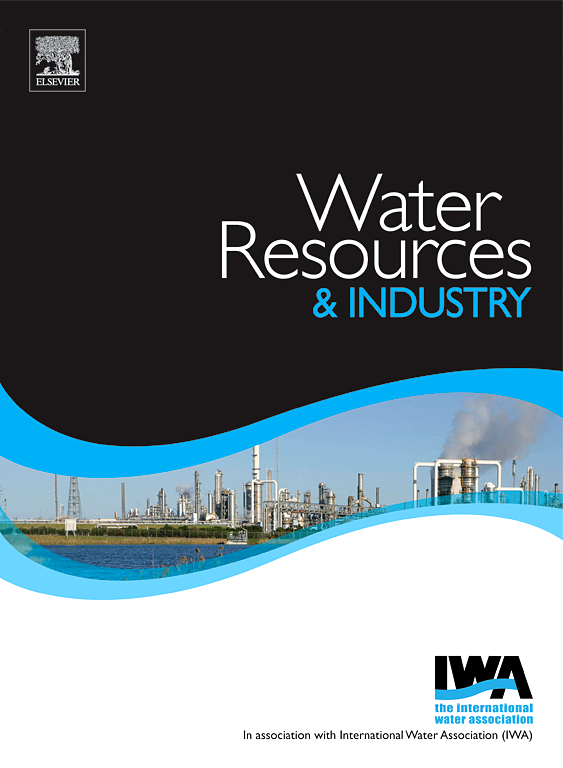工业污水处理厂中新兴有机污染物的发生、去除和生态风险评估
IF 4.5
3区 工程技术
Q1 WATER RESOURCES
引用次数: 0
摘要
新兴有机污染物(EOCs)由于其持久性和毒性对水生环境造成了重大影响。本研究分析了中国某工业污水处理厂水相和污泥中8类68种EOCs的发生情况,该污水处理厂由常规生物处理和深度处理(纤维过滤加氯化)组成。结果表明,生物处理(PhMs为84.8%,ATBs为79.2%)和高级处理(PhMs为78.6%,ATBs为64.7%)对药物(PhMs)和抗生素(ATBs)的有效去除。对杀虫剂(PEST)、邻苯二甲酸酯(PAEs)、有机磷酸酯(OPEs)和紫外线过滤器(UVFS)的总去除率分别为56.4%、22.3%、56.7%和49.6%。相比之下,全氟烷基化学品(PFAS)无去除(- 68.5%)。质量平衡分析表明,OPEs、PhMs和UVFS主要通过生物降解去除,ATBs主要通过污泥吸附去除。该研究还发现了分配系数(LogKd)与辛醇-水分配系数(logKow)之间的相关性。生态风险商强调全氟辛烷磺酸(PFOS)、吡虫啉(IMI)和噻虫胺(CLO)是高风险污染物。研究结果表明,污水处理厂的二级和高级联合处理工艺可有效去除PhMs(96.7%)和ATBs(92.6%)等EOCs,为开发靶向技术降低EOCs风险提供了指导。本文章由计算机程序翻译,如有差异,请以英文原文为准。
Occurrence, removal, and ecological risk assessment of Emerging organic contaminants in an industrial WWTP
Emerging organic contaminants (EOCs) pose significant impacts to the aquatic environment due to their persistence and toxicity. This study analyzed the occurrence of 68 EOCs in eight categories in the water phase and sludge at an industrial WWTP in China consisting of a conventional biotreatment and an advanced treatment (fiber filtration plus chlorination). The results demonstrated effective removal of pharmaceuticals (PhMs) and antibiotics (ATBs) through biotreatment (84.8 % for PhMs, 79.2 % for ATBs) and advanced treatment (78.6 % for PhMs, 64.7 % for ATBs). The total removal efficiencies of Pesticides (PEST), phthalate esters (PAEs), organophosphate esters (OPEs), and UV filters (UVFS) were 56.4 %, 22.3 %, 56.7 %, and 49.6 %, respectively. In contrast, no removal of perfluoroalkyl chemicals (PFAS) (−68.5 %). Mass balance analysis revealed that OPEs, PhMs and UVFS were mainly removed through biodegradation, while ATBs were mainly removed through sludge adsorption. The study also found a correlation between the partition coefficients (LogKd) and their octanol-water partition coefficients (logKow). The ecological risk quotient highlighted perfluorooctanesulfonate (PFOS), imidacloprid (IMI), and clothianidin (CLO) as high-risk contaminants. This study reveals the combined process of secondary and advanced treatment in WWTPs can effectively remove EOCs, such as PhMs (96.7 %) and ATBs (92.6 %), providing guidance for the development of targeted technologies to mitigate the risks of EOCs.
求助全文
通过发布文献求助,成功后即可免费获取论文全文。
去求助
来源期刊

Water Resources and Industry
Social Sciences-Geography, Planning and Development
CiteScore
8.10
自引率
5.90%
发文量
23
审稿时长
75 days
期刊介绍:
Water Resources and Industry moves research to innovation by focusing on the role industry plays in the exploitation, management and treatment of water resources. Different industries use radically different water resources in their production processes, while they produce, treat and dispose a wide variety of wastewater qualities. Depending on the geographical location of the facilities, the impact on the local resources will vary, pre-empting the applicability of one single approach. The aims and scope of the journal include: -Industrial water footprint assessment - an evaluation of tools and methodologies -What constitutes good corporate governance and policy and how to evaluate water-related risk -What constitutes good stakeholder collaboration and engagement -New technologies enabling companies to better manage water resources -Integration of water and energy and of water treatment and production processes in industry
 求助内容:
求助内容: 应助结果提醒方式:
应助结果提醒方式:


